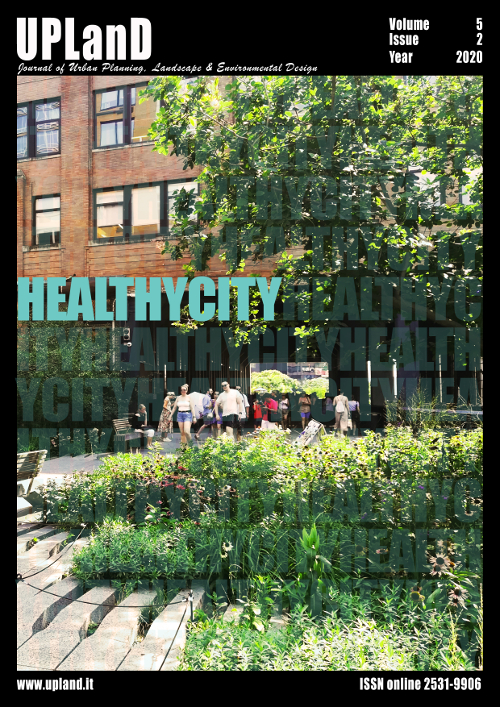SLOW Aquileia, during and after the pandemic. A strategic agenda for the re-action and adaptation of a small town
Main Article Content
Abstract
The work in progress “SLOW Aquileia. A strategic agenda for re-ACTIVE spaces during and after Covid-19” questions how to cope with structural health, climate and environmental risks through adaptation actions and tools that are specifically tailored to small and low-density urban centers. Aquileia is a town in the Italian region Friuli Venezia Giulia, where the threats to safety, livability and economy brought about by pandemic are not connected to urban concentration, but rather to the fragmentation of public spaces, services and entrepreneurial activities. In this small city, the low population density, the abundance of urban open spaces and the proximity to rural areas have helped limit the number of infections. However, the difficulties in guaranteeing the cultural offer are having serious impacts on the local economy and the municipal finances. To make Aquileia able to re-act to present and future risks, the planning process developed by the Municipality, with the Universities of Trieste, Udine and Iuav of Venezia, focuses on the issues of preparedness and care (of the territory and its inhabitants), and on a deep rethinking of existing facilities. New projects and tools are defined by coordinating slow and fast transformations, tactical and structural interventions. Due to a significant presence of archaeological sites and institutions, the dialogue among territorial actors is no less important. In a post-pandemic perspective, the aim of SLOW Aquileia is to integrate the enhancement of cultural heritage, urban and rural landscapes, with the improvement of the inhabitants’ daily life, through both strong synergies in the ways and times to use public spaces and equipment, and the creation of services in support of new economic chains among creative enterprises, tourism, and local agriculture.
Downloads
Article Details

This work is licensed under a Creative Commons Attribution-NonCommercial-NoDerivatives 4.0 International License.
Authors who publish with this journal agree to the following terms:- Authors retain copyright and grant the journal right of first publication with the work simultaneously licensed under a Creative Commons Attribution License that allows others to share the work with an acknowledgement of the work's authorship and initial publication in this journal.
- Authors are able to enter into separate, additional contractual arrangements for the non-exclusive distribution of the journal's published version of the work (e.g., post it to an institutional repository or publish it in a book), with an acknowledgement of its initial publication in this journal.
- Authors are permitted and encouraged to post their work online (e.g., in institutional repositories or on their website) prior to and during the submission process, as it can lead to productive exchanges, as well as earlier and greater citation of published work (See The Effect of Open Access).
References
Basso, S., & Marchigiani, E. (2019). Attrezzare piccoli e medi centri urbani. Pianificazione in Friuli Venezia Giulia. Territorio, 90, 62-70.
Bianchetti, C. (2020). Bodies. Between Space and Design. Jovis.
Bifulco, L., & Centemeri, L. (2020). Città, preparedness e salute. Working Papers Urban@it, 1, 1-6.
Cersosimo, D., & Donzelli, C. (eds.) (2020). Manifesto per riabitare l’Italia. Donzelli.
Commission on Social Determinants of Health (2008). Closing the Gap in a Generation. Health Equity Through Action on the Social Determinants of Health. World Health Organization. https://www.who.int/social_determinants/final_report/csdh_finalreport_2008.pdf
Comune di Aquileia (2020, August 5). Presentazione pubblica SLOW Aquileia. https://bit.ly/3iZcK6O
De Rossi, A. (ed.) (2018). Riabitare l’Italia. Le aree interne tra abbandoni e riconquiste. Donzelli.
Di Marco, L. (2020). Obiettivi di sviluppo sostenibile e politiche europee. Dal Green Deal al Next Generation EU. Quaderni di ASVIS, 1. ASVIS. https://asvis.it/public/asvis2/files/Pubblicazioni/Quaderno_Obiettivi_di_sviluppo_sostenibile_e_politiche_europee.pdf
Dorato, E. (2020). Preventive Urbanism. The Role of Health in Designing Active Cities. Quodlibet.
European Commission (2018). A New European Agenda for culture – Background Information. https://ec.europa.eu/culture/document/new-european-agenda-culture-swd2018-267-final
Forum Disuguaglianze Diversità (2020, May 6). Durante e dopo la crisi: per un mondo diverso. Perché, cosa, come, con chi. https://www.forumdisuguaglianzediversita.org/wp-content/uploads/2020/05/ForumDD_Durante-e-dopo-la-crisi.-Per-un-mondo-diverso.x89907.pdf
Gargiulo, C. (ed.) (2020). 2020 Covid-19 vs City-20. Scenarios, Insights, Reasoning and Research. TeMA, S.I.
Istituto Nazionale di Urbanistica (2021). Città accessibili a tutti. Indirizzi, esperienze e prospettive di miglioramento del funzionamento urbano. http://atlantecittaccessibili.inu.it
Lakoff, A. (2017). Unprepared: Global Health in a Time of Emergency. University of California Press.
Landry, C., Crescenzi, R., Bartolo, A., Cullen, C., del Mar Delgado-Serrano, M., Kabisch, S., Liakou, L., Matko, M., Rok, A., Stikker, M., & Cartuyvels, P. (2019). The Human-Centred City: Opportunities for citizens through research and innovation. Publications Office of the European Union. doi:10.2777/859158
Lanzani, A., Curci, F., De Leo, D., & Kërçuku, A. (2020, February 17-18). L’Italia di mezzo tra metropoli e aree interne. Seminario Ricomporre i divari Politiche e progetti territoriali contro le disuguaglianze, Politecnico di Milano. https://www.eccellenza.dastu.polimi.it/wp-content/uploads/2020/04/1.3_L_Italia-di-mezzo-EDIT.pdf
Lydon, M., & Garcia, A. (2015). Tactical Urbanism: Short-term Action for Long-term Change. Island Press.
Marchigiani, E., Perrone, C., & Esposito De Vita, G. (2020), Oltre il Covid, politiche ecologiche territoriali per aree interne e dintorni. Uno sguardo in-between su territori marginali e fragili, verso nuovi progetti di coesione. Working Papers Urban@it, 1, 1-9. https://www.urbanit.it/wp-content/uploads/2020/07/BP_Marchiggiani_Perrone_DeVita.pdf
Micelli, E. (2020, May 21). La metropoli aperta, inclusiva e creativa è sotto accusa. cheFare. https://www.che-fare.com/micelli-metropoli-luogo-competenze-citta
Pasqui, G. (2020, March 18). L’impatto della pandemia sui territori fragili: pensieri per il ‘dopo’. Gli stati generali. https://www.glistatigenerali.com/beni-comuni/pandemia-urbanistica-urbanistica-architettura-coronavirus
Regione Autonoma Friuli Venezia Giulia (2021a). Smart Accelerators of Cultural Heritage Enterpreneurship. https://www.regione.fvg.it/rafvg/cms/RAFVG/cultura-sport/progetti-bandi-europei/FOGLIA10/
Regione Autonoma Friuli Venezia Giulia (2021b). Eliminazione barriere architettoniche – Contributi ai comuni. https://www.regione.fvg.it/rafvg/cms/RAFVG/infrastrutture-lavori-pubblici/FOGLIA1
Ricci, G. (2020, May 14), Le politiche urbane del post-lockdown come occasioni per trasformazioni radicali. Domus. https://www.domusweb.it/it/architettura/gallery/2020/05/14/politiche-urbane-post-lockdown-occasione-trasformazioni-radicali-urbanistica-tattica-mobilit%C3%A0-bicicletta-coronavirus.html
Secchi, B. (2000). Prima lezione di urbanistica. Laterza.
Vazzoler, N. (2020a, May 4), SLOW AQUILEIA. Un documento preliminare per una città che si confronta con l’emergenza Covid-19. U3 – UrbanisticaTre. http://www.urbanisticatre.uniroma3.it/dipsu/?m=202005
Vazzoler, N. (2020b), Una visione per Aquileia. Per una pubblica amministrazione sostenibile. Working Papers Urban@it, 2, 1-9. https://www.urbanit.it/wp-content/uploads/2020/10/BP_Vazzoler.pdf

